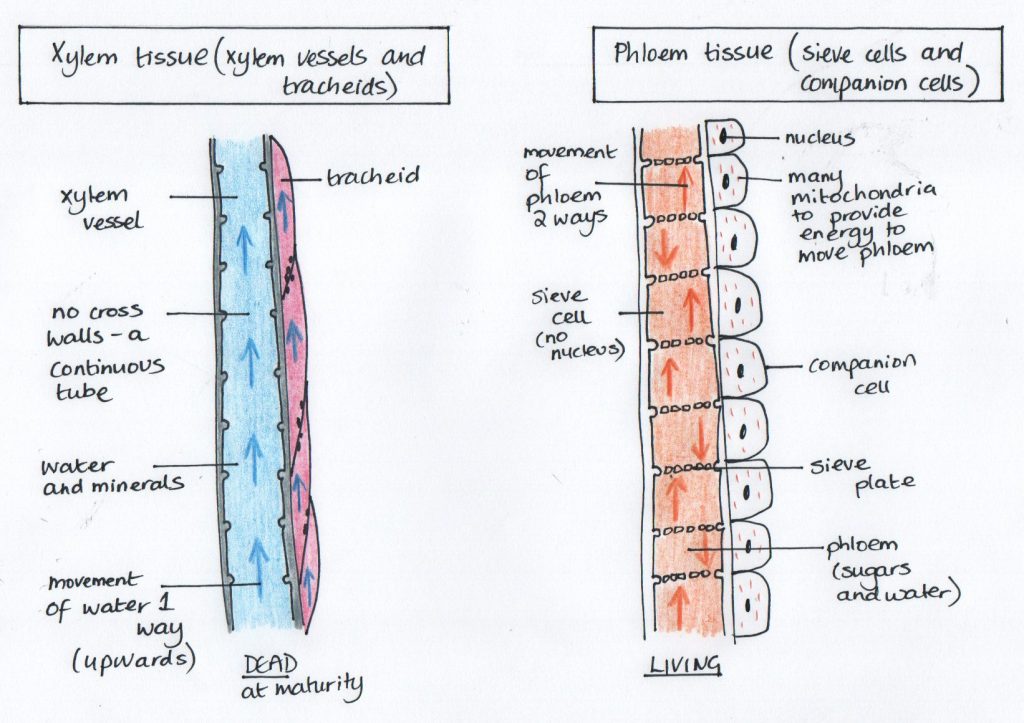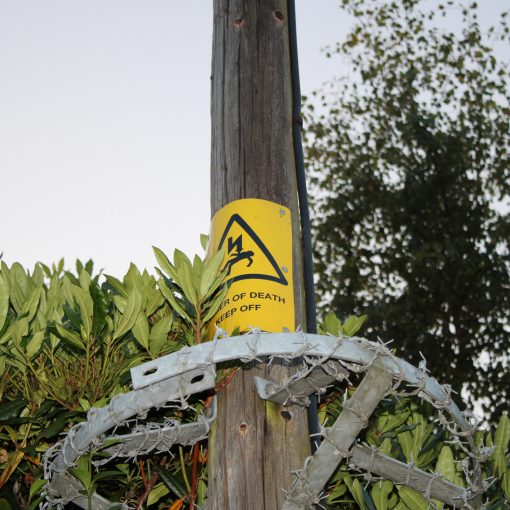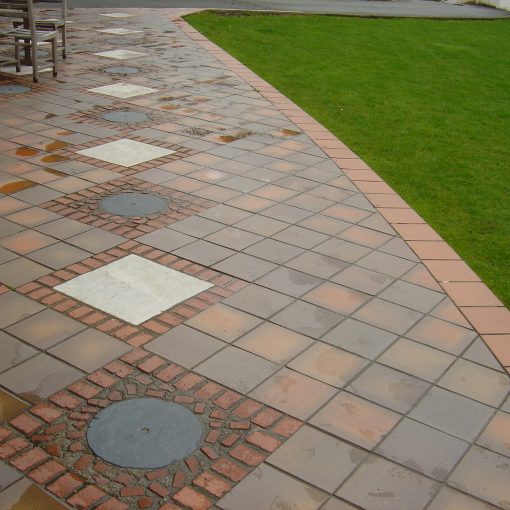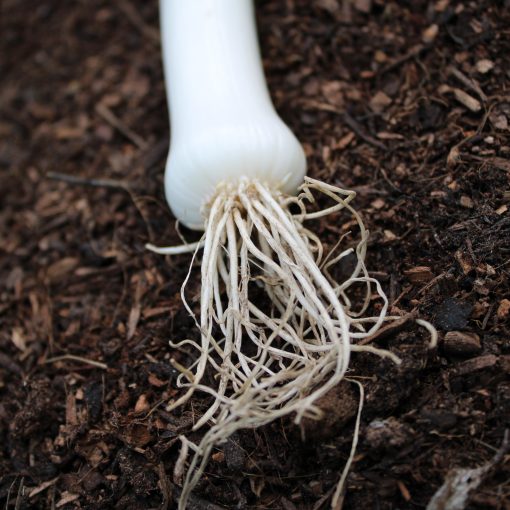Relevant to the old syllabus R2101. There is some relevance to the new syllabus Unit 1 Topic 1 (science) but the detail of the different types of tissue such as protective, transport, packing and meristematic does not need to be learnt in as much detail for the exam.
The learning outcomes for the old syllabus are as follows:
State what is meant by the term ‘plant tissue’.
Describe the characteristics and function of: protective (epidermis), meristematic (cambium), transport (phloem, xylem) and packing (parenchyma) plant tissues.
Introduction
Tissues are a really hard topic to get your head around before you cover each of the major plant organs. There is a summary video at the end if you are more of a visual learner.
The following will make a lot more sense if you are familiar with the internal structure of the root, stem and leaf of a dicotyledonous/eudicotyledonous plant as well as plant processes such as photosynthesis, respiration and transpiration.
Definition of tissue : A plant tissue is made up of a group of similar cells designed to perform a particular function.
Tissues made up of only one cell type are called simple tissues. An example is parenchyma tissue (made up of parenchyma cells) Tissues made up of more than one type of cell are called complex tissues. Examples are phloem tissue and xylem tissue.
There are four broad types of tissue in the RHS level 2 OLD syllabus:
- Protective (Epidermis / dermal tissue) – specialised to protect the outside of the plant and prevent water loss from leaves.
- Packing (Parenchyma tissue) Situated between the vascular tissue and the epidermal tissue. Parenchyma is a type of ground tissue. There are other types of ground tissue which are not covered in the syllabus such as sclerenchyma and collenchyma.
- Transport (Vascular tissue) – specialised for transporting water, nutrients and sugars i.e. xylem tissue (water & minerals) & phloem tissue (sugars in solution).
- Meristematic tissue (Cells capable of rapid division)
Meristematic tissue generates the three types of tissue already listed. Meristematic tissue is found at all growing points in the plant such as root tip, shoot tip and in the vascular cambium.
As you learn how to draw and label the main plant organs such as the root, stem and leaf the 4 tissue groups listed above are repeatedly labelled. Here are colour coded diagrams for a dicotyledonous / eudicotyledonous plant showing these tissues in the root, stem and leaf:



Overview of each tissue type – Characteristics and function
For the following to make sense you need to be familiar with the internal features and processes which happen in the root, stem and leaf.
1. Protective tissue: Epidermis / Epidermal tissue (Look at the pink tissue in the diagrams above)
Characteristics
This is the external surface of a plant. The epidermis is made up of a single sheet of tightly packed close fitting cells with no spaces between the cells. It often has a waxy surface layer called the cuticle (not in roots) In the leaf it is transparent to allow light penetration. The epidermis can have modified cells which have a special function: trichomes in stem (hairs), root (root hairs) and leaf (hairs) and guard cells in the lower epidermis of the leaf.
Function
As well as containing the internal structures of the plant, the main function of the epidermis is protection of the plant. The tightly packed band of cells and waxy cuticle prevent excess water being lost from the stem and leaf surface. It also prevents diseases and pests attacking the plant by providing a physical barrier. Some trichomes such as nettles have a specialised defence function by stinging.
Other more specialised functions include water absorption through root hairs (a large surface area) allowing gases into and out of the leaf and allowing water to exit the leaf via the stomata. The stomatal opening and closing is controlled by the guard cells found in the epidermis.
2. Packing tissue : Parenchyma tissue (look at the bright yellow tissue in the diagrams above)
Characteristics
This is a simple tissue made up of one type of cell. They are generally rounded with air spaces between them and have thin walls and large vacuoles. Parenchyma in the leaf (pallisade mesophyl) contain many chloroplasts and parenchyma in the root (cortex) may contain starch grains.
Function
It is a packing tissue which supports the plant when the vacuoles are fully turgid.
In the root the cortex is made of parenchyma cells and may store sugars in the form of starch here. (eg carrot) In the leaf the palisade mesophyll cells (parenchyma cells) have many chloroplasts and their main function is photosynthesis.
3. Transport tissue: Xylem and phloem tissue (Look at the green xylem and orange phloem in the diagrams above)
The 3 diagrams of organs show cross sections of these tissues but to understand the cells in each tissue type. a longitudinal section drawing will help:

i) Xylem tissue
Characteristics
Xylem tissue is a transport tissue made up of xylem vessels and tracheids. Xylem vessels are made of columns of cells whose walls have broken down and are dead at maturity. These hollow tubes are reinforced with lignin which gives strength to the xylem vessels. Tracheids are tapered elongated cells with pits which connect together.
Function
Xylem tissue transports water from the roots up the stem to the leaves.(only in one direction) The hollow tubes allow water to move up in a continuous column and as lignin is water proof it does not move through the cell walls. It is xylem tissue which forms the major wood structure in tree trunks.
ii) Phloem tissue
Characteristics
Phloem tissue is a living transport tissue made up of sieve cells and companion cells.
The sieve cell walls are partially broken down to form sieve tubes. The companion cells support the sieve cells by providing energy as they contain many mitochondria.
Function
Phloem tissue transports sugars in solution which the plant has manufactured by photosynthesis to other parts of the plant where the sugars are needed. Phloem is a mixture of sugars and minerals in solution and moves up and down (Both directions) within the phloem tissue.
4. Meristematic tissue (Dividing tissue) (Look at the purple colour in the diagrams above)
Characteristics
Meristem tissue gives rise to all the other tissue types so are undifferentiated. Undifferentiated means they have not yet become specialised.
This is tissue which rapidly divides to form new cells and is therefore essential for growth. Cells are densely packed, have large nuclei and no vacuole. There is no vacuole as it doesn’t have a structural function. They also have many mitochondria to provide energy for cell division. Meristems are found in areas where growth occurs. For level 2 study meristems are found:
- At the tip of the shoot and root (apical meristems) which cause lengthening growth.
- In the vascular cambium.
Function
The function of meristematic tissue is cell division and growth
The vascular cambium is labelled in purple in the diagrams. It is found between the xylem and phloem and gives rise to sideways growth (lateral growth) which is also called secondary thickening. It is only present in dicotyledons (not monocotyledons)
The following summary table shows the tissue type, different examples of this tissue type and the characteristics of the tissue type.




And finally…
Here is a link to a video I have made showing the main tissues using diagrams and models https://youtu.be/5j_qNGm0-jA






